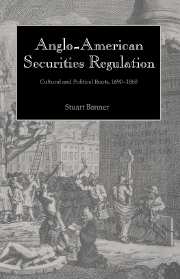Book contents
- Frontmatter
- Contents
- Selected statutes and cases
- Acknowledgments
- Note on dates
- Abbreviations
- Introduction
- 1 English attitudes toward securities trading at its inception, 1690–1720
- 2 The South Sea Bubble and English law, 1720–1722
- 3 English securities regulation in the eighteenth century
- 4 The development of American attitudes toward securities trading, 1720–1792
- 5 American securities regulation, 1789–1800
- 6 American attitudes toward securities trading, 1792–1860
- 7 American securities regulation, 1800–1860
- 8 Self-regulation by the New York brokers, 1791–1860
- Conclusion
- Bibliography
- Index
8 - Self-regulation by the New York brokers, 1791–1860
Published online by Cambridge University Press: 23 October 2009
- Frontmatter
- Contents
- Selected statutes and cases
- Acknowledgments
- Note on dates
- Abbreviations
- Introduction
- 1 English attitudes toward securities trading at its inception, 1690–1720
- 2 The South Sea Bubble and English law, 1720–1722
- 3 English securities regulation in the eighteenth century
- 4 The development of American attitudes toward securities trading, 1720–1792
- 5 American securities regulation, 1789–1800
- 6 American attitudes toward securities trading, 1792–1860
- 7 American securities regulation, 1800–1860
- 8 Self-regulation by the New York brokers, 1791–1860
- Conclusion
- Bibliography
- Index
Summary
Government was not the only regulator of the securities market in the first half of the nineteenth century. The stockjobbers regulated themselves as well, at first tentatively in the late eighteenth century, and then with increasing confidence as the nineteenth century progressed. By the 1820s, the New York Stock and Exchange Board encompassed a miniature private legal system, which formulated rules governing the market and resolved disputes involving members. Because most time bargains were unenforceable in the New York courts until 1858, this dispute resolution mechanism was the only one available for the enforcement of such transactions, a circumstance which made membership in the Board more attractive, and strengthened the Board's position as a market regulator generally. By the middle of the century, the regulation produced by the Stock and Exchange Board was almost certainly of greater significance to the trading community than the regulation produced by the state of New York or any other unit of government.
Section I of this chapter will describe the origin and growth of the New York Stock and Exchange Board (the organization would shorten its name in 1863 to the New York Stock Exchange). Section II will discuss the functions the Board performed for its members, in order to understand why the Board was formed and how it could have been so successful. Section III will look more closely at the ways in which the Board regulated the securities market.
- Type
- Chapter
- Information
- Anglo-American Securities RegulationCultural and Political Roots, 1690–1860, pp. 250 - 280Publisher: Cambridge University PressPrint publication year: 1998



